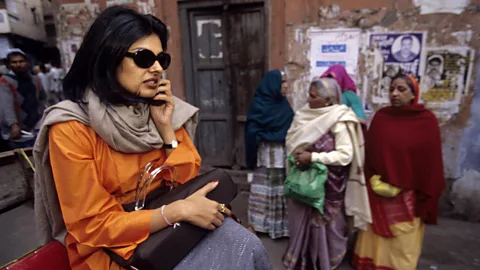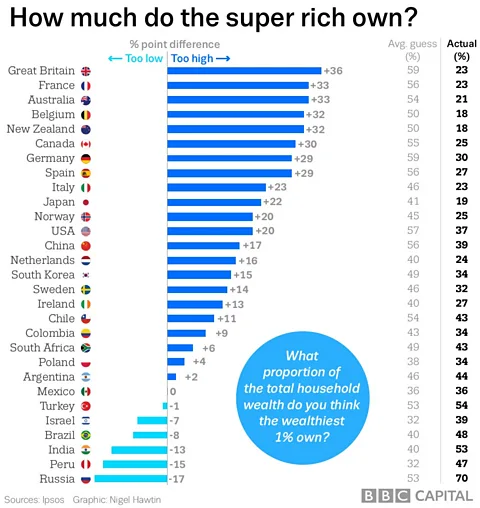What we just don't understand about the 1%
 Getty Images
Getty ImagesComprehending the growing divide.
We’re bidding farewell to 2018 with some of BBC Capital’s greatest hits from over the last year. With these compelling stories, indispensable tips and expert insight, you’ll be ready to make 2019 the best it can be.
The results of the US mid-term elections continues the theme of stark division seen in recent political outcomes around the world. Not only are the US House of Representatives and Senate now controlled by different parties but the early analysis shows a series of very close races driven by gaps between rural, suburban and urban areas, ethnicity and economic position.
Barack Obama echoed this theme in a recent rare intervention into the public debate in the US to highlight how worried he feels about the threats to democracy and progress posed by increasing economic inequality, and how this drives social divisions.
In my opinion, he’s right to be worried. The concentration of wealth at the top really has grown. And not just in the US. In 2017, for the first time since we’ve had reliable wealth measurement drawn from national statistics, the top 1% wealthiest people in the world owned more than the rest of the population put together.
But when survey researchers ask people to guess what proportion of the wealth the top 1% in their respective countries own, they’re often way out, as seen in Ipsos’ Perils of Perception studies.

Click or pinch to zoom on mobile.
Britain and France were the worst at guessing. The actual proportion of wealth owned by the top 1% in both countries is the same, at 23%. But Brits thought the top 1% owned 59% of wealth while the French thought it was 56%.
Although people in some surprising countries did underestimate this concentration of wealth. The average guess in Russia was that the top 1% own 53% of the wealth, which is actually not that different from the guess in the UK and France. But the reality is far worse, the top 1% in Russia actually own an extraordinary 70% of the country’s wealth, three times the level of the UK and France.
The US also stands out as one of the most unequal countries for wealth distribution among the rich nations included in the study, with the top 1% owning 37% of the country’s wealth, but with the guess again less optimistic, similar to France and the UK, at 57%
So, why are we so out of kilter with reality?
A big part of the explanation lies in our emotional reaction, rather than our lack of knowledge of the facts.
Like Obama, we know inequality is a growing issue, and we hear regular, vivid anecdotes of excess running alongside stories of the real poverty experienced by many, so our guesses can become exaggerated. Whether we’re entirely conscious of it or not, we’re partly sending a message that this is a big and worrying issue: inequality looms large in our minds, so we literally inflate the figures.
Social psychologists have a term for this phenomenon, they label it: ‘emotional innumeracy’. This means that when we ask people to guess at the scale of an issue, cause and effect run in both directions: we’re not just worried about things that we think are big issues, we exaggerate the scale of issues that we’re already worried about.
Emotional innumeracy points to a vital conclusion: because our misperceptions of reality are partly emotional, simple “myth-busting” – telling people they’re wrong on the facts – will not really help that much, because it misdiagnoses the cause. Our misperceptions are often not about ignorance, but more about a world view driven by our underlying attitudes and beliefs.
We also asked people what they thought the top 1% should own, and this reveals some fascinating patterns.
First, people are mostly not calling for complete equality of wealth – with the averages running from people saying the top 1% should have 14% of wealth in Israel to 32% in China.
Some people in all countries do want complete wealth parity though – and Britain is highest on this: 19% of Brits said the top 1% should only have 1%, followed closely by Russia, where 18 % said they should only have 1%.

Click or pinch to zoom on mobile.
But, second, if we go back to the averages of what we say inequality should be and compare that with the actual level, something immediately jumps out: on the surface, people seem pretty comfortable with the current state of wealth inequality in many countries.
For example, the French said the top 1% should own 27%, when they actually ‘only’ currently own 23%. A simplistic reading of this is that the French – a country that has ‘égalité’ (equality) as part of its national strapline – are saying give the wealthiest a bit more.
Of course, that’s the completely wrong interpretation.
We know from our question on how people see the ‘reality’, that the French on average thought the top 1% currently own 56% of the country’s wealth. So, what they’re really saying is that the very wealthy should have about half what they currently have.
This points to a key benefit of understanding our many misperceptions on finances and wealth: we need to know what people think the current situation is before we ask them what they think it should be. Or, the other way round: not knowing how wrong we are about realities can lead us to very wrong conclusions about what we should do.
Bobby Duffy is author of The Perils of Perception. He is professor of public policy and director of The Policy Institute, King’s College London and formerly and managing global director of Ipsos Social Research Institute.
--
To comment on this story or anything else you have seen on BBC Capital, please head over to our Facebook page or message us on Twitter.
If you liked this story, sign up for the weekly bbc.com features newsletter called "If You Only Read 6 Things This Week". A handpicked selection of stories from BBC Future, Culture, Capital and Travel, delivered to your inbox every Friday.
